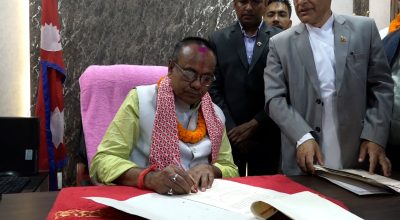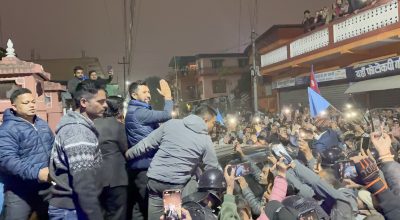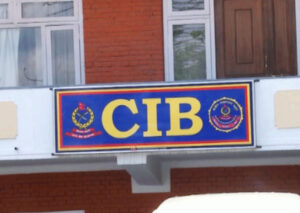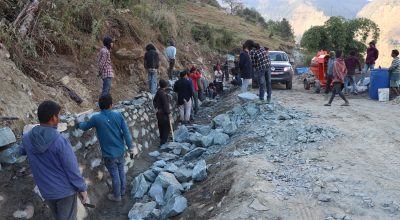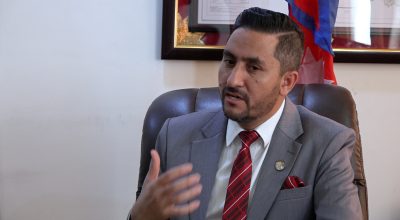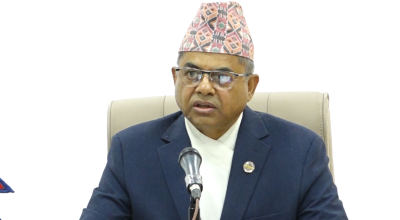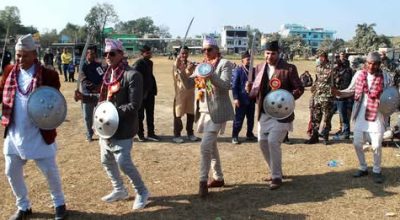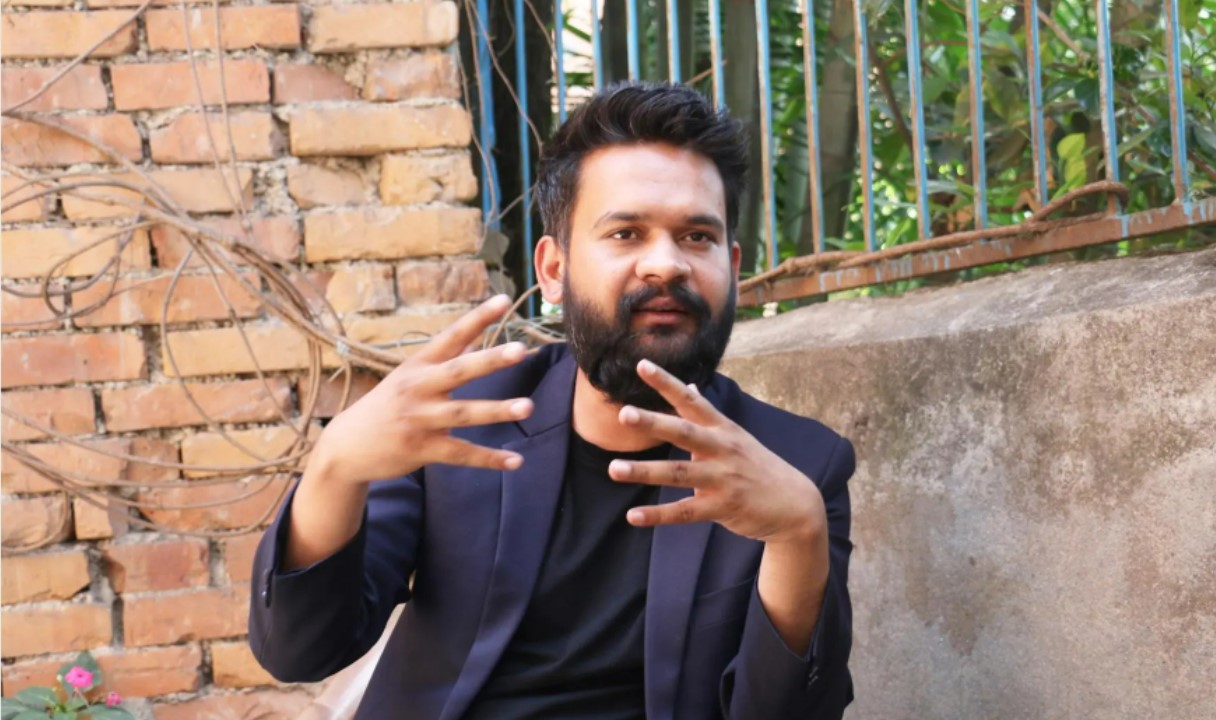
KATHMANDU: Independent candidate Balendra Shah has sealed victory in the local election in the Kathmandu Metropolitan City (KMC). He secured 61,767 votes and was elected the Mayor of the federal capital. He defeated Srijana Singh of the Nepali Congress, the common candidate of the ruling five-party alliance, and the CPN (UML)’s candidate Keshav Sthapit in the election.
The 32-year-old Shah is also a rapper known by the name ‘Balen’. He has completed Bachelor’s degree in Civil Engineering from Himalayan White House Institute of technology and Master’s in Structural Engineering from the Karnatak Biswesworaiya National Polytechnic Institute of India.
The Constitution of Nepal has defined the local level as the local government. Secondary education, basic health, water supply and sanitation, language, culture conservation and development among other sectors fall under the scope of works of the local government. There are many instances that show that the local levels can make huge stride in development in a short time given the people’s representatives have the will power.
Here are the excerpts of an interview with the newly-elected mayor:
You’ve been elected as the Mayor of Kathmandu. What are your plans and priorities?
Education and health is my first priority. The 92 community schools in the metropolis area would be upgraded to provide quality education. We will be starting the school improvement with small things. The school infrastructures would be developed. We will upgrade the schools before the student enrolment so that the people will be able to feel the improvement. The infrastructure, sanitation and clean environment would be set up. Playground required for the students would be managed.

We will make arrangements for providing the training for teachers on the use of technology in teaching-learning activities and the interaction to be done with the students by bringing experts from foreign countries. This will enhance the relations between teachers and students. We will prepare an environment in which the children will be happy to go to school. We will reform the curriculum from Grade 1 to 8. We will prepare the syllabus on the history, culture and heritage of Kathmandu, ayurveda, yoga and meditation in an easy-to-understand format for the students. With this, the students will be able to provide full information about the art, culture and history when they meet the visitors from within the country and abroad in their city in the future. We can take Bhaktapur as an example of this. The children in Bhaktapur Municipality have information about the history, art, culture, musical instruments and foods in their city. Every person should have knowledge about the local art, culture and history.
Do you mean the syllabus prepared by the Metropolis before this has not included these topics?
The curriculum before this has not incorporated many things. We should produce the human resources that can explain this in practice and in written form as well. There are many books to understand the art, culture and cultural wealth of this place, but we lack the human resources who can explain all these. We have forwarded a plan of enhancing the quality of education technologically as well. The technology is changing rapidly. Students can understand easily when the teaching is done by showing examples by means of ‘3-D visuals’.
At present, education has become something like a burden. An environment would be created in which the students will enjoy school. An interaction would be organized once a week on topics outside the syllabus in which the students are interested. Someone might be interested in assembling robot, some might be interested in singing and dancing while others in arts and theatre. This extra-curricular activity one day a week will bring out the hidden talent in the students. This extra skill besides the education degree will also help in the earning. Our aim is to make the students capable.

How are you going to make the community schools lacking infrastructures and students well-managed?
We are going to ‘merge’ these types of schools. Some schools lack play ground while others lack sufficient class rooms. We can manage such schools and their teachers by merging these schools. We shall merge such schools on the basis of requirement and not randomly. Our wish is that students start coming to the community schools from the private ones.
On learning and teaching activities through 3D visualisation you have proposed, how can you provide access to technology for children with extreme low incomes?
Schools will provide mobile phones and technology. It is not that 3D visualisation will be applicable throughout from grade 1 to 10. It will apply in installment, like from grades 10 in the beginning. Children will be tech-savvy when they get grades 10.
There should be reforms in custom in schools and teachers should be corrected. Teachers should take responsibility for a student getting failure. Students’ morale could be decreased by pointing to their weakness in the beginning. This will not help increase quality education. It is wrong to blame students and parents for all shortcomings occurred in school. Children are in school from morning to evening. So why parents are blamed for shortcomings they commit in school? This blame game is a bad trend. Education on relations between teachers and students and other moral behaviours should be imparted. Education begins from custom.
How would be standards of education of the Metropolis during your tenure of five years as its mayor?
In the first place, people’s psychology to educational infrastructure should be changed. Parents on their part look at an elevator as school’s important infrastructure. But an elevator does not help with teaching and learning activities. Such people’s psychology would be gradually changed.
We will carry out reforms in school’s toilets and gardens. Classrooms and toilets can be made disabled people friendly. Required materials like sanitary pads can be managed. Required budget will be allocated and its implementation be monitored effectively.

How will you manage health service?
Ward clinics will be set up in all 32 wards of the metropolis. A ward clinic will have doctors, nurses and a laboratory. One can get general health tests of body parts like heart, kidney, liver, blood pressure and diabetes at ward clinic. The health test will be free at least once in six months. Similarly, plans are afoot to carry out screening for womb and breast cancer. Parks will be constructed in various places for people to do physical exercises.
There is a plan to increase facilities in government hospitals. Ways on how to stop specialists from going for foreign jobs will be discussed. Telemedicine service will come into operation. Health service could be provided by setting aside some portion of personal property and house rent taxes as health insurance premium. This will also encourage residents of Kathmandu to pay personal property and house rent taxes.
The Melamchi project has to some extent addressed water demand in Kathmandu. But it is not enough. How will you fully address water problem in the city?
Existing bore water will be provided to people in the city. To increase underground water level, we should recharge its level through the use of rainwater. Rainwater should be stored into a five-foot pit dug wherein the soil absorbs it, thus increasing underground water level.
For a house storing rainwater would be suffice water demand for 10 houses. One should compulsorily dig a reserve pit.
Rainwater could be stored by digging small ponds in the premises of public places and government offices. This will increase underground water level and water level of water resources, thus ending drinking water problem to some extent.
Water supplies from the Melamchi River have resumed. The Capital receives 170 million liters of water from the Melamchi on a daily basis in the first phase and the daily supplies from other sources here amount to 130 million liters. We need 430 million liters of water daily.
Now our focus will be on recharging the sources of water and restoring traditional stone spouts. It is possible by digging a pond on the source of stone spouts. The Ward 17 alone has over 17 stone spouts. Water to be extracted from such sources of water could be collected in tanks before the supplies.
Management of solid wastes in the Kathmandu Valley remains as a constant challenge for the local governments. Do you have any idea for finding a long lasting solution to this issue?
A Sisdole-based dumping site in Nuwakot has been used for the disposal of wastes collected from the Kathmandu Valley. A new dumping site equipped with an incinerator cell at Bancharedanda is yet to be fully operated and its monitoring has been carried neither from the Metropolis nor the concerned Ministry. We will complete the project as sooner as possible. The placement of more incinerators at different locations would largely contribute to reducing the quantity of disposable solid waste. More the practice of separating biodegradable and non-biodegradable garbage within the sources could be helpful in systematising the waste management procedures. We will urge the Metropolis people to follow the practice and different vehicles will be used to collect them in a different day. More we will place separate waste disposal containers (for biodegradable and non-biodegradable) in public. The separation of wasters within the source make it easier to use biodegradable wastes as raw materials for organic fertilizer manufacturing and the production could be supplied to neighbouring Kavrepalanchowk and Dhading districts.
In addition to this, we plan to take arable land in surrounding district on least for farming and it will contribute to creating jobs for some human resource. We have opportunities but youths are opting for foreign employments in absence of the guarantee of jobs at home. The practice could be used as a tool to retain youth force. Youths will prefer to seek a job career within the home if job is guaranteed here. More, the Metropolis folks could get fresh and organic vegetables if the plan became successful.
What is your plan to systematise the Metropolis traffic system and parking sites/lots?
Prior to this, odd-hour transport facility was in place in the town. Public transport would available in the capital till 10:00 pm but it could not be continued in absence of an expected number of passengers as the service failed to target office staffs. We could amend the office duty- hours. Offices could be operated in different shifts including in odd hours to resume the night bus service. We plan to fix 10,000 CCTVs for the safety of night travel in the Metropolis in the first phase. We will train town police. Every bus to be operated in night will be equipped with CCTV and GPS. The presence of night street lights will be further strengthened.
What is your plan to promote the electric vehicles?
The metropolis will obviously increase investment to promote the use of electric vehicles. Fuel- based vehicles that are presently providing services here should not be replaced, instead the owners should be encouraged to opt for electric services. Transport entrepreneurs should be given time to transform the business gradually.
What are the ways you suggest to make the public transport safe and reliable?
Public vehicles to be operated by the Metropolis and private sector will be have the equal capacity and they will be operated under a same umbrella. Passengers will have a smart card for ticketing and it will be validated in each public vehicle, route remaining under the umbrella organision of the metropolis. This model is in practice in neighbouring China, India and other developing countries. It will discourage vehicles to wait unnecessary in hope of getting more passengers which is one of the reasons behind a traffic jam in Kathmandu.
There are complaints that the roads in Kathmandu are not bicycle-friendly. What’s your say?
Marking green on the lanes does not make ‘bicycle lanes’. ‘Bicycle lanes’ must be separately built from the main road. There should be garden in the middle. It is not possible to make separate ‘bicycle lanes’ in the Kathmandu as roads here are narrow. Designating a separate lane for bicycle would further narrow the roads.
We have to be see things from pragmatic viewpoint. Tram, monorails are not plausible in Kathmandu. Separate ‘bicycle lanes’ can be constructed while constructing outer Ring Road. The city dwellers suffering due to lack of coordination among various agencies in infrastructure construction, aren’t they?
For instance, the Department of Road builds the road. Each road has definite density, temperature and Compaq. The KMC monitors these factors. I myself am an engineer. I know it as well. There is no monitoring in the construction sites.
While cementing the roads, the quality of the materials used while cementing is overlooked. Whatever the contractors submit as a report that is accepted and agreed. This will be no longer the case now. The construction materials used while building the roads will be tested in the metropolis’s labs. We will make monitoring and surveillance further effective. We will put in place ‘Infrastructure Ambulance’ to repair the potholes in the roads immediately.
Greenery is prerequisite for urban beauty. What are your plans for making the Metropolis a ‘greener city’?
Plants will be planted in every house, in each vacant land and alongside the footpath. There is a provision of ‘one house, one tree’ which is not implemented effectively.
The metropolis will provide fruit-bearing saplings to every tax payers in the metropolis. The citizens will plant and protect it if it reaps them fruits. To make it mandatory, the metropolis will make decision in policy making level.
There are a total of 45 empty spaces in the metropolis. We will develop it in such a manner that those places could be utilized for various purposes. This could also ensure greenery in the metropolitan area. Also, we are thinking of constructing vertical garden. We will urge the concerned sides to dig ponds and plant trees in the vacant land in the public offices.
Can’t we manage hoarding boards and wires?
There are separate rules for management of hoarding boards and wires. That has not been enforced effectively yet. We will strictly implement it to streamline the boarding boards and unmanaged wires.
There are citizens facing difficulties in lack of public toilets. How would you solve this issue?
We will build public toilets in the land occupied by public offices by taking a small piece of land on lease. Such toilets could be built on a small plot of land by demolishing a bit of fences of those offices in coordination.
Also, we have also discussed with the restaurateurs in the city to make additional arrangement for public toilets. The toilets of the restaurants could be used by the public. We can consider some discount in taxation for such toilets that will be marked by special signs.
Public can use those toilets without obtaining permission from anyone. Once the Kathmandu Metropolis develops such culture, it would be emulated nationwide. In fact, it would also help those restaurants grow business.
How would you promote culture, art and cultural splendour of Kathmandu?
No efforts will be spared to keep arts, culture, heritages and civilization alive. We have discussed with the Bhaktapur Municipality regarding this in various rounds. We will put in place training centres to produce and train artisans for conservation of woodworks and sculptures here.
I have been advocating that we need ‘Arniko’ to preserve and conserve the ancient art and culture of Kathmandu. I myself have studied deeply about history of Lichchhavi and Malla era. Cultures should be linked with tourism.
We are considering increase in budget for promotion and protection of tourism, culture and heritages. This will have a positive impact on the lives of people and on the country’s economy.
You are elected as an independent candidate. Your colleagues are representatives of political parties. How do you coordinate?
Leader and cadres alike of all political parties have cast their ballot to me. Those elected in the ward chairperson posts have also voted for me. There is no question of not allowing me to work. All are ‘in my support’.
Furthermore, the top leaders of all political parties and competitors for mayoral race have been telephoning me and expressing their commitment to support me. Like I have said, we will broadcast each executive meetings live. Who wouldn’t want to work for the greater good of people?
Lastly, is there anything you want to say?
The people of Kathmandu Metropolis have cast their ballot to me and given me an opportunity to take the lead. They certainly have great faith in me. I will not let them down.
Development is not possible by sole effort. It takes collective effort. Hence, I will coordinate effort with 18 municipalities in the Kathmandu Valley and forge a common concept to move forward the development works.
If we succeed to develop Kathmandu as a model city, other municipalities will also be inspired. We should learn from the past and make future result-oriented for which we need support from all quarters.
(Interview by Ashok Ghimire/Sharmila Pathak and Nabin Poudel/RSS)






